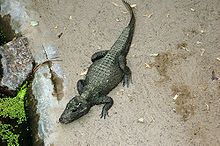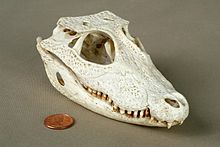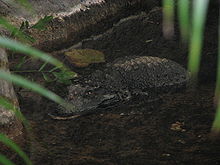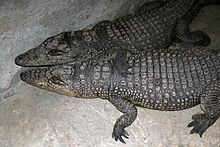- Dwarf crocodile
-
Dwarf crocodile West African Dwarf Crocodile Conservation status Scientific classification Kingdom: Animalia Phylum: Chordata Class: Sauropsida Order: Crocodilia Family: Crocodylidae Genus: Osteolaemus
Cope, 1861Species: O. tetraspis Binomial name Osteolaemus tetraspis
Cope, 1861Subspecies - O. t. tetraspis Wermuth & Mertens (1961)
- O. t. osborni (Schmidt (1919)) Wermuth & Mertens (1961)
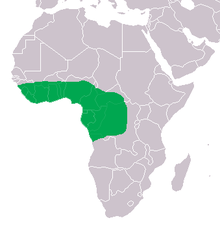
Range of the Dwarf Crocodile in green The dwarf crocodile (Osteolaemus tetraspis) is an African species of crocodile. It is also the smallest extant crocodile species in the world. Recent sampling has identified three genetically distinct populations. Some feel that the findings should elevate the subspecies to full species status.
Contents
Physical description
Dwarf crocodiles attain a medium adult length of 1.5 meters (5 feet), though the maximum recorded length for this species is 1.9 meters (6.2 feet). Adults are a uniform black on their backs and sides with a yellowish underside with black patches. Juveniles have a lighter brown banding on body and tails and yellow patterns on the head.
As a result of its small size and heightened vulnerability to predation, this species of crocodile has a heavily armoured neck, back and tail and also has osteoderms on its belly and underside of neck.
Osteolaemus has a blunt short snout, as long as it is wide, similar in fact to that of a dwarf caiman, probably a result of occupying a similar ecological niche. The dentition consists of 4 premaxillary teeth, 12 to 13 on the maxilla and 14 to 15 on the dentary bone.
O. tetraspis has lighter colours, a more pointed, upturned snout and more body armour than O. osborni.
Habitat and range
Dwarf crocodiles range across tropical lowland regions of sub-Saharan West Africa and West Central Africa. Such a distribution greatly overlaps with that of the slender-snouted crocodile, encompassing countries as far West as Senegal, reaching the Central African Republic in the East, and ranging as southerly as Angola. The subspecies O. t. tetraspis is found mainly in the westerly reaches of this range while O. t. osborni is restricted to the Democratic Republic of Congo's rain forest.
Osteolaemus individuals reside in permanent ponds in swamps and areas of slight current of rain forest rivers, though reports exist of dwarf crocodiles in isolated pools in the savannah, where burrows are dug to aestivate during the dry season.
Ecology and behaviour
The dwarf crocodile is a slow, timid, and mainly nocturnal reptile. As with all crocodilians, it is an adept predator of vertebrates, large invertebrates such as crustaceans and, when presented with the opportunity, also eats carrion. Foraging is mainly done in or near the water, though in areas with substantial ground cover, they may expand their feeding pattern to land in extensive forays, specially following rains.
The Congo Basin subspecies demonstrates seasonality in its dietary regime, feeding on fish during the wet season's floods. When faced with the scarceness of food during the dry season, individuals turn to crustaceans and food intake is generally reduced.
True to its solitary, nocturnal nature, a dwarf crocodile digs out a burrow to hide in and rest during the day, which can sometimes have a submerged entrance. An individual lacking the right conditions to do so usually abides between tree roots that hang over the ponds in which it lives.
Reproduction
Interacting closely only in breeding season, female dwarf crocodiles build their nest mounds at the beginning of the wet season, which spans May and June. The nest, situated near the water, is a mound of wet, decaying vegetation that incubates the eggs due to the heat generated by the decomposition of the plant material. A small number of eggs are laid, numbering about 10, though in extreme cases it can go up to 20 eggs, and they incubate in 85 to 105 days. Hatchlings measure 28 cm when emerging from the eggs. The female guards the nest during the incubation period and after the eggs hatch it watches over the young for an unknown period of time as young can be eaten, as in other of crocodiles, by a great range of predators (birds, fish, mammals and reptiles, including other crocodiles).
Conservation
Dwarf crocodiles are a little known species so, unlike their more studied relatives, conservationists aren't as aware of how their populations are faring under the growing human pressure over the ecosystems where they abide. Where survey data is available, it shows some degree of decline, either by hunting for bush meat or habitat loss due to deforestation. However, it is a widely spread, and presumably numerous, species so is not as endangered as other forest denizens.
Though some skins are used in local manufacturing of leather products, they are of poor quality, so there is little interest in captive breeding or a sustainable use program.
Classification
Osteolaemus tetraspis is currently the only species included in the genus Osteolaemus, with two recognized subspecies:
- Osteolaemus tetraspis tetraspis
- Osteolaemus tetraspis osborni Congo (or Osborn’s) dwarf crocodile
The second subspecies has had a somewhat convoluted taxonomical history. It was first described as Osteoblepharon osborni by Schmidt in 1919, based on a few specimens from the Upper Congo Basin in what is now the Democratic Republic of Congo. However Inger in a 1948 paper found the specimens wanting of characteristics that would justify a generic separation from Osteolaemus and referred the specimens to Osteolaemus osborni. Later, Wermuth and Mertens (1961), reduced it to the current subspecies rank.
Recent evidence from the analysis of DNA indicates that there are three distinctly different populations of Osteolaemus that may merit full species recognition. These would be O. tetrapis, O. osborni, and a third currently unnamed species.
Etymology
The generic name Osteolaemus means "bony throat", and is derived from the Ancient Greek οστεον (bone) and λαιμος (throat). The genus was named as such due to the osteoderms found among the scales in the neck and belly.
The specific epithet tetraspis means "four shields", and derives from the Ancient Greek τετρα (four) and ασπις (shield), as the back of the neck has four large shield-like scales.
Alternate names
This species is also known by various names in English:
- African broad-nosed crocodile
- African caiman
- African dwarf crocodile
- Black crocodile
- Bony crocodile
- Broad-snouted crocodile
- Rough-backed crocodile
- West African dwarf crocodile
Notes and further reading
- Dwarf crocodile at the Encyclopedia of Life
- Osteolaemus tetraspis@Crocodilian Species List
- Osteolaemus tetraspis@Crocodile Status Survey and Conservation Action Plan - Second Edition
Extant Crocodilian species Kingdom: Animalia · Phylum: Chordata · Class: Sauropsida · (unranked): Archosauria · Superorder: Crocodylomorpha Family Gavialidae Family Alligatoridae Alligatorinae
(Alligators)Caimaninae
(Caimans)Related articles on alligators, caimans, crocodiles and gharials Topics Human
interactionU.S. Alligator fatalities · Crocodile attacks · Alligator farm · Crocodile tears · Famous crocodiles and alligators · Sewer alligatorCategories:- IUCN Red List vulnerable species
- Crocodilians
- Crocodylidae
- Reptiles of Africa
- Reptiles of Sierra Leone
Wikimedia Foundation. 2010.

